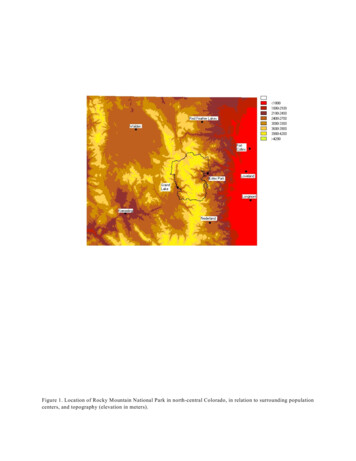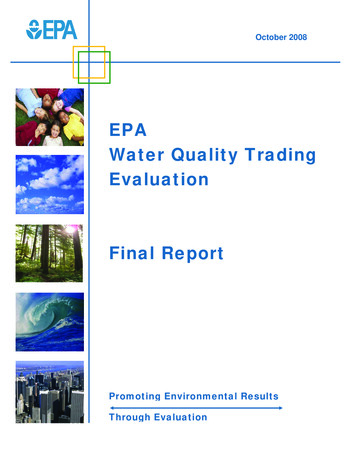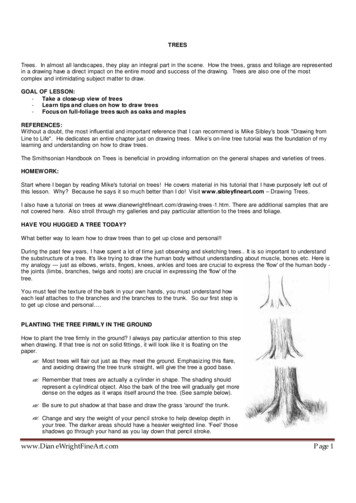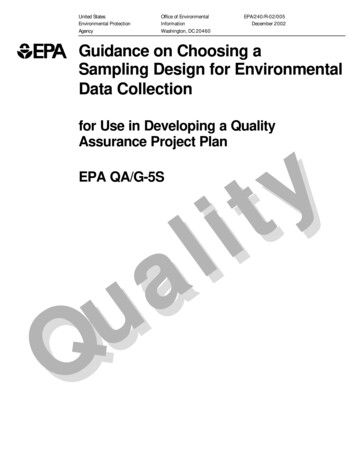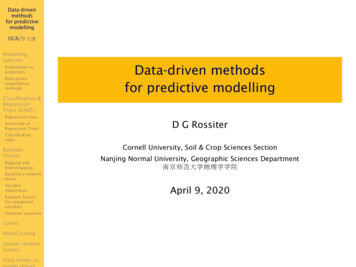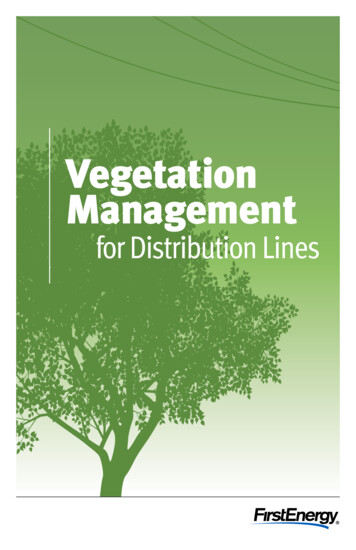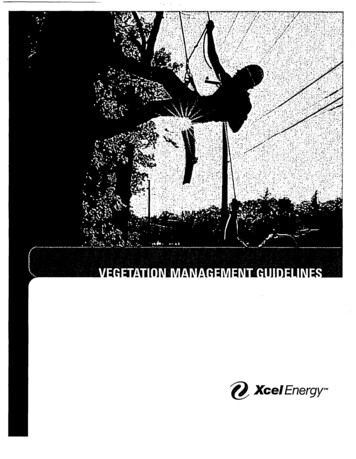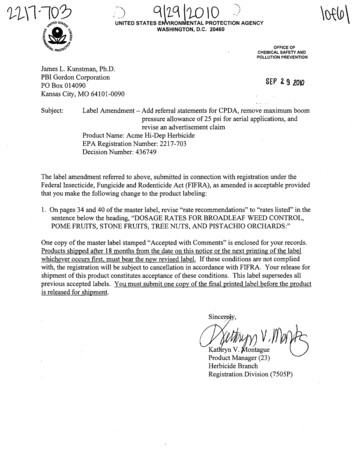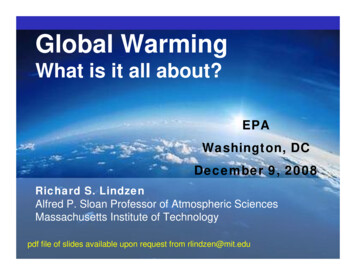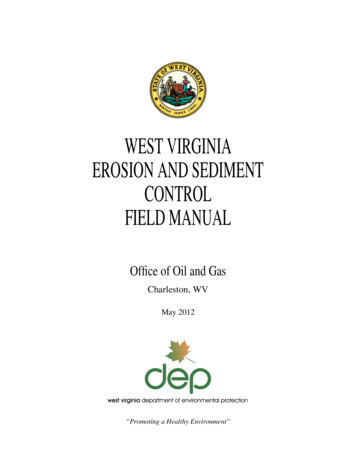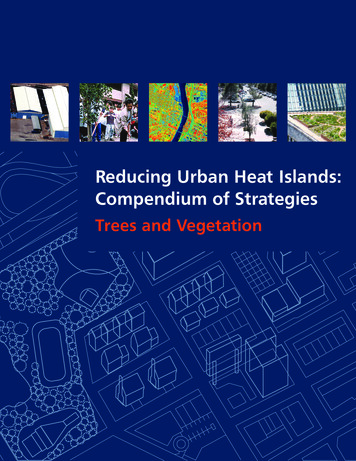
Transcription
Reducing Urban Heat Islands:Compendium of StrategiesTrees and Vegetation
AcknowledgementsReducing Urban Heat Islands: Compendium of Strategies describes thecauses and impacts of summertime urban heat islands and promotesstrategies for lowering temperatures in U.S. communities. This compendiumwas developed by the Climate Protection Partnership Division in the U.S.Environmental Protection Agency’s Office of Atmospheric Programs. EvaWong managed its overall development. Kathleen Hogan, Julie Rosenberg,and Andrea Denny provided editorial support. Numerous EPA staff inoffices throughout the Agency contributed content and provided reviews.Subject area experts from other organizations around the United States andCanada also committed their time to provide technical feedback.Under contracts 68-W-02-029 and EP-C-06-003, Perrin Quarles Associates,Inc. provided technical and administrative support for the entirecompendium, and Eastern Research Group, Inc. provided graphics andproduction services.PositvEnergy provided support in preparing the Trees and Vegetation, CoolRoofs, and UHI Activities chapters under contract PO #2W-0361-SATX.Experts who helped shape this chapter include:Ryan Bell, David Cole, Ben DeAngelo, Lynn Desaultes, Ed Dickerhoff, MauryEstes, Gordon Heisler, David Hitchcock, Kim Klunich, Cheryl Kollin, MeganLewis, Julie Magee, Greg McPherson, Dave Nowak, Philip Rodbell, JoyceRosenthal, Misha Sarkovich, Kathy Wolf, Jim Yarbrough, and Barry Zalph.
ContentsTrees and Vegetation . . . . . . . . . . . . . . . . . . . . . . . . . . . . . . . . . . . . . . . . . . . . .11. How It Works . . . . . . . . . . . . . . . . . . . . . . . . . . . . . . . . . . . . . . . . . . . . . . . . . . . . . . . . . . . . . . . . .22. Using Trees and Vegetation in the Urban Landscape . . . . . . . . . . . . . . . . . . . . . . . . . . .33. Benefits and Costs . . . . . . . . . . . . . . . . . . . . . . . . . . . . . . . . . . . . . . . . . . . . . . . . . . . . . . . . . . . .53.1 Benefits . . . . . . . . . . . . . . . . . . . . . . . . . . . . . . . . . . . . . . . . . . . . . . . . . . . . . . . . . . . . . . . . .53.2 Potential Adverse Impacts. . . . . . . . . . . . . . . . . . . . . . . . . . . . . . . . . . . . . . . . . . . . . . . .93.3 Costs . . . . . . . . . . . . . . . . . . . . . . . . . . . . . . . . . . . . . . . . . . . . . . . . . . . . . . . . . . . . . . . . . . .113.4 Benefit-Cost Considerations . . . . . . . . . . . . . . . . . . . . . . . . . . . . . . . . . . . . . . . . . . . . .114. Other Factors to Consider . . . . . . . . . . . . . . . . . . . . . . . . . . . . . . . . . . . . . . . . . . . . . . . . . . . .124.1 Planting Considerations. . . . . . . . . . . . . . . . . . . . . . . . . . . . . . . . . . . . . . . . . . . . . . . . .124.2 Maintenance . . . . . . . . . . . . . . . . . . . . . . . . . . . . . . . . . . . . . . . . . . . . . . . . . . . . . . . . . . .144.3 Safety . . . . . . . . . . . . . . . . . . . . . . . . . . . . . . . . . . . . . . . . . . . . . . . . . . . . . . . . . . . . . . . . . .155. Urban Forestry Initiatives . . . . . . . . . . . . . . . . . . . . . . . . . . . . . . . . . . . . . . . . . . . . . . . . . . . .156. Resources . . . . . . . . . . . . . . . . . . . . . . . . . . . . . . . . . . . . . . . . . . . . . . . . . . . . . . . . . . . . . . . . . . .196.1 Plant Selection. . . . . . . . . . . . . . . . . . . . . . . . . . . . . . . . . . . . . . . . . . . . . . . . . . . . . . . . . .196.2 Benefit-Cost and Other Tools . . . . . . . . . . . . . . . . . . . . . . . . . . . . . . . . . . . . . . . . . . . .216.3 General Information . . . . . . . . . . . . . . . . . . . . . . . . . . . . . . . . . . . . . . . . . . . . . . . . . . . .24Endnotes. . . . . . . . . . . . . . . . . . . . . . . . . . . . . . . . . . . . . . . . . . . . . . . . . . . . . . . . . . . . . . . . . . . . . . .26
Trees and VegetationShade trees and smaller plants such as shrubs, vines, grasses, and ground cover, helpcool the urban environment. Yet, many U.S. communities have lost trees and greenspace as they have grown. This change is not inevitable. Many communities can takeadvantage of existing space, such as grassy or barren areas, to increase their vegetativecover and reap multiple benefits.Opportunities to Expand the Use of Urban Treesand VegetationLand Cover (%): Above the CanopyMost U.S. communities have opportunities to increase the use of trees and vegeta tion. As part of the U.S. Environmental Protection Agency’s (EPA’s) Urban Heat IslandPilot Project, the Lawrence Berkeley National Laboratory conducted analyses toestimate baseline land use and tree cover information for the pilot program cities.1Figure 1 shows the percentage of vegetated and barren land cover in four of theseurban areas. The high percentage of grass and barren land cover show the space po tentially available forFigure 1: Land Cover Statistics for Various U.S. Citiesadditional tree canopy(Above Tree Canopy)cover. The statistics donot show the loss30of dense vegetated25cover as cities ex pand, however. For20example, a 2005Grassreport estimates thatTrees15Houston lost 10 mil Barrenlion trees per year10from 1992 to 2000.250ChicagotRees ANd VeGetAtION – dRAFtHoustonSacramentoSalt Lake City1
1 . How It WorksFigure 2: Vegetative Cover in New York CityNew York City reveals how developed areas (gray andwhite in this image) can replace vegetation (green).Central Park is highlighted by the orange rectangle.This chapter outlines some of the issuescommunities might consider in determin ing whether and how to expand the use oftrees and vegetation so as to mitigate urbanheat island conditions. Among the topicscovered in this chapter are: How trees and vegetation reducetemperatures Some of the benefits and costs associ ated with trees and vegetation Other factors a mitigation programmight consider Urban forestry initiatives Tools and resources for furtherinformation.Shading. Leaves and branches reducethe amount of solar radiation that reachesthe area below the canopy of a tree orplant. The amount of sunlight transmittedthrough the canopy varies based on plantspecies. In the summertime, generally 10 to30 percent of the sun’s energy reaches thearea below a tree, with the remainder be ing absorbed by leaves and used for pho tosynthesis, and some being reflected backinto the atmosphere. In winter, the rangeof sunlight transmitted through a tree ismuch wider—10 to 80 percent—becauseevergreen and deciduous trees have dif ferent wintertime foliage, with deciduoustrees losing their leaves and allowing moresunlight through.3Figure 3: Trees Shade a HomeSteve CundyNASA/GSFC/METI/ERSDAC/JAROS and U.S./Japan ASTER Science TeamTrees and vegetation help cool urban climatesthrough shading and evapotranspiration.Tree canopies, such as the deciduous trees around thishome in Virginia, can block much of the sunlight fromreaching the ground or the building.2RedUcING URBAN HeAt IslANds – dRAFt
Shading reduces surface temperaturesbelow the tree canopy. These cooler sur faces, in turn, reduce the heat transmittedinto buildings and the atmosphere. Forexample, a multi-month study measuredmaximum surface temperature reductionsranging from 20 to 45ºF (11-25ºC) for wallsand roofs at two buildings.4 Another studyexamined the effects of vines on wall tem peratures and found reductions of up to36ºF (20ºC).5 A third study found that treeshading reduces the temperatures insideparked cars by about 45ºF (25ºC).6Evapotranspiration. Trees and vegeta tion absorb water through their roots andemit it through their leaves—this move ment of water is called “transpiration.” Alarge oak tree, for example, can transpire40,000 gallons of water per year; an acre ofcorn can transpire 3,000 to 4,000 gallons aday.7 Evaporation, the conversion of waterfrom a liquid to a gas, also occurs fromthe soil around vegetation and from treesand vegetation as they intercept rainfall onleaves and other surfaces. Together, theseFigure 4: piration, alone or in combina tion with shading, can help reduce peaksummer air temperatures. Various studies8,9have measured the following reductions: Peak air temperatures in tree grovesthat are 9ºF (5ºC) cooler than overopen terrain. Air temperatures over irrigated agri cultural fields that are 6ºF (3ºC) coolerthan air over bare ground. Suburban areas with mature trees thatare 4 to 6ºF (2 to 3ºC) cooler than newsuburbs without trees. Temperatures over grass sports fieldsthat are 2 to 4ºF (1 to 2ºC) cooler thanover bordering areas.Trees and other large vegetation can alsoserve as windbreaks or wind shields toreduce the wind speed in the vicinity ofbuildings. In the summertime, the impactscan be positive and negative. In the win tertime, reducing wind speeds, particularlycold north winds, can provide substantialenergy benefits.2 . Using Trees and Vegetation inthe Urban LandscapeTranspirationStomataprocesses are referred to as evapotranspi ration. Evapotranspiration cools the air byusing heat from the air to evaporate water.EvaporationRootPlants take water from the ground through their rootsand emit it through their leaves, a process known astranspiration. Water can also evaporate from tree surfaces,such as the stalk, or surrounding soil.tRees ANd VeGetAtION – dRAFtTrees and vegetation are most useful as amitigation strategy when planted in strate gic locations around buildings. Researchershave found that planting deciduous speciesto the west is typically most effective forcooling a building, especially if these treesshade windows and part of the building’sroof. Shading the east side of a structurealso reduces air conditioning demand.10,11Planting trees to the south generally lowerssummertime energy demand, but must be3
Shading pavement in parking lots and onstreets can be an effective way to help coola community. Trees can be planted aroundperimeters and in medians inside parkinglots or along the length of streets. Strategi cally placed shade trees also can benefitplaygrounds, schoolyards, ball fields, andsimilar open spaces.Trees are not the only vegetation option.There are many areas where trees either donot fit or grow too slowly to be effectiveover the short term, in which case vinesmay work better. Vines need less soil andFigure 6: Vines to Shade a WallTrellis Structures, Inc.done carefully. Depending on the trees, thebuilding’s height, and the distance betweenthe trees and a building, trees may be det rimental to an energy efficiency strategy ifthey block useful solar energy in the win ter, when the sun is low in the sky, withoutproviding much shade during the summer,when the sun is high in the sky.Vines grown on trellises can provide a quick,simple source of shade.space and grow very quickly. Vines grownon the west side of a building, for example,will shade the exterior wall and reduce itssurface temperature, thus reducing heatgain inside the building. The vines willprovide some air cooling benefits throughevapotranspiration as well.Figure 5: Tree Placement to Maximize Energy SavingsBlock winter winds withevergreen treesLocate trees to westor east of houseShadeA/C UnitLocate trees at least5-10’ but less than30-50’ from houseVines on trellisshade patioVines overdrivewayPicking the right trees and putting them in the right location will maximize their ability to shadebuildings and block winds throughout the year.4RedUcING URBAN HeAt IslANds – dRAFt
3 . Benefits and CostsThe use of trees and vegetation in theurban environment brings many benefits,including lower energy use, reduced airpollution and greenhouse gas emissions,protection from harmful exposure to ul traviolet (UV) rays, decreased stormwaterrunoff, potential reduced pavement main tenance, and other quality-of-life benefits.At the same time, communities must alsoconsider the costs of an urban forestry pro gram and any potential negative impacts ofincreasing tree and vegetation cover. Thefollowing sections address these benefitsand costs in more detail. Section 6 of thischapter summarizes software tools that cal culate the range of potential benefits fromurban tree and vegetation initiatives.U.S. Department of Agriculture(USDA) Forest Service research cen ters offer links to publications aboutstudies of trees and their benefits tourban areas. See www.fs.fed.us/ne/syracuse/Pubs/pubs.htm and www.fs.fed.us/psw/programs/cufr/ .3.1 BenefitsReduced Energy Use. Trees and vegeta tion that provide direct shading reduceenergy needed to cool buildings. Benefitsvary based on the orientation and size ofthe plantings, as well as their distance froma building. Large trees planted close to thewest side of a building will generally pro vide greater cooling energy savings thanother plants.The examples below from a variety of stud ies highlight cooling and year-round en ergy savings from trees and vegetation.tRees ANd VeGetAtION – dRAFt Joint studies by the Lawrence BerkeleyNational Laboratory (LBNL) and theSacramento Municipal Utility District(SMUD) placed varying numbers of treesaround houses to shade windows andthen measured the buildings’ energyuse.12,13 The cooling energy savingsranged between 7 and 47 percent andwere greatest when trees were planted tothe west and southwest of buildings.14 A USDA Forest Service study inves tigated the energy savings resultingfrom SMUD’s residential tree plantingprogram. This study included over 250program participants in the Sacra mento, California, area, and estimatedthe effect of new shade trees plantedaround houses. An average of 3 newtrees were planted within 10 feet (3 m)of each house.15 Annual cooling energysavings were 1 percent per tree, andannual heating energy use decreasedby almost 2 percent per tree. The treesprovided net wintertime benefits be cause the positive wind shielding ef fect outweighed the negative effect ofadded shade. Another LBNL study simulated theeffects of trees on homes in variouscommunities throughout the UnitedStates. Assuming one tree was plantedto the west and another to the southof a house, the model predicted that a20-percent tree canopy over the housewould result in annual cooling savingsof 8 to 18 percent and annual heatingsavings of 2 to 8 percent.16 Althoughthis particular model included ben efits from trees planted to the south ofa building, experts generally suggestplanting to the west and east of build ings, taking care when planting to thesouth to avoid blocking desired solarheat gain in the winter.175
Reduced Air Pollution and GreenhouseGas Emissions. In addition to saving en ergy, the use of trees and vegetation as amitigation strategy can provide air qualityand greenhouse gas benefits: Leaves remove various pollutants fromthe air, referred to as “dry deposition” Shade trees reduce evaporative emis sions from parked vehicles Trees and vegetation remove andstore carbon Trees and vegetation reduce green house gas emissions from power plantsby reducing energy demand.Researchers have investigated the potentialfor expanding urban tree and vegetativecover to address air quality concerns, suchas ground-level ozone. One study pre dicted that increasing the urban canopy ofNew York City by 10 percent could lowerground-level ozone by about 3 percent,which is significant, particularly in placesneeding to decrease emissions to meet airquality standards for this pollutant.18Pollutant Removal through Dry Depo sition. Plants generally take up gaseouspollutants, primarily through leaf stomata,that then react with water inside theplant to form acids and other chemicals.Plants can also intercept particulate mat ter as wind currents blow particulates intocontact with the plants’ surfaces. Someparticulates are absorbed into the plantwhile others adhere to the surface, wherethey can be resuspended into the atmo sphere by winds or washed off by rain tothe soil beneath.19 These processes canreduce various pollutants found in theurban environment, including particulatematter (PM), nitrogen oxides (NOX), sulfurdioxide (SO2), carbon monoxide (CO), andground-level ozone (O3).6Various studies have documented howurban trees can reduce pollutants. A 2006study estimated total annual air pollutantremoval by urban trees in the United Statesat 784,000 tons, with a value of 3.8 bil lion.20 The study focused only on deposi tion of ground-level ozone, PM less than 10microns in diameter (PM10), nitrogen diox ide (NO2), SO2, and CO. Although the esti mated changes in local ambient air qualitywere modest, typically less than 1 percent,the study noted that additional benefitswould be gained if urban temperature andenergy impacts from trees and vegetationwere also included.Reduced Evaporative Emissions. Treeshade can keep parked cars—particularlytheir gas tanks—cooler, which lowersevaporative emissions of volatile organiccompounds (VOCs), a critical precursorpollutant in the formation of ground-levelozone. Most large urban areas have a widerange of control programs to reduce theseemissions, and tree shading programs canbe part of those strategies. For example,one analysis predicted that light-dutyvehicle evaporative VOC emission ratesthroughout Sacramento County could bereduced by 2 percent per day if the com munity increased the tree canopy overparking lots from 8 to 50 percent.21Carbon Storage and Sequestration. Astrees grow, they remove carbon from theatmosphere and store, or sequester, it. Astrees die or deposit litter and debris on theground, carbon is released to the atmo sphere or transferred to the soil. The neteffect of this carbon cycle is a substantiallevel of carbon storage in trees, vegetation,and soils.The net rate of carbon sequestered byurban trees in the continental United Statesin 2005 is estimated to have been around24 million tons per year (88.5 million tonsRedUcING URBAN HeAt IslANds – dRAFt
Plants and Carbon:Storage versusSequestrationStorage: Carbon currently held inplant tissue (tree bole, branches, androots).Sequestration: The estimatedamount of carbon removed annuallyby plants, through the process ofphotosynthesis.CO2eq)22, while current total carbon stor age in urban trees in the continental UnitedStates is approximately 700 million tons ofcarbon. The national average urban forestcarbon storage density is just over 25 tonsper hectare (100,000 square feet, or 9,300m2), but varies widely from one communityto another and corresponds generally tothe percentage of land with tree cover andto tree size and health.23 The California AirResources Board recently approved guide lines that will allow carbon sequesteredfrom forests to help meet the carbon emis sions reductions stipulated by California’slaw AB32.24Reduction in Greenhouse Gas Emis sions through Reduced Energy Demand.As noted above, trees and vegetation candecrease energy demand. To the extent thatreduced energy consumption decreases fos sil fuel burning in power plants, trees andvegetation also contribute to lower carbonemissions from those power plants. Onemodeling study estimated that the directenergy savings from shading alone by treesand vegetation could reduce carbon emis sions in various U.S. metropolitan areasby roughly 1.5 to 5 percent.25 The studyassumed that eight shade trees would betRees ANd VeGetAtION – dRAFtplaced strategically around residential andoffice buildings and four around retailstores. As urban forests also contribute toair temperature reductions, the study foundthat there would be additional reductionsin energy use and carbon emissions fromthose indirect effects as well.Full Life-cycle Carbon Reductions. In or der to investigate the full life-cycle impactof urban trees on annual CO2 emissions,researchers consider: Annual CO2 carbon sequestration rates Annual CO2 releases from decomposition Annual CO2 releases from maintenanceactivities Annual CO2 avoided emissions becauseof reduced energy use.By combining these four variables, re searchers can estimate the net CO2 reduc tions from urban forest resources for aspecific community and calculate the asso ciated net monetary benefits. A 2006 fieldstudy found that about 15,000 inventoriedstreet trees in Charleston, South Carolina,were responsible for an annual net re duction of over 1,500 tons of CO2. Thesebenefits were worth about 1.50 per tree,based on average carbon credit prices.26Improved Human Health. By reducingair pollution, trees and vegetation lowerthe negative health consequences of poorair quality. Also, similar to the benefits ofcool roofs discussed in the “Cool Roof”chapter, shade trees can reduce heat gainin buildings, which can help lower indoorair temperatures and minimize the healthimpacts from summertime heat waves.A third health benefit from trees and veg etation involves reducing direct exposureto UV rays. The sun’s UV rays can haveadverse health effects on the skin and eyes.7
High levels of long-term exposure to UVrays are linked to skin cancer. The shadeprovided by dense tree canopies can helpto lower UV exposure, although this shouldnot be considered a primary preventivemeasure (see text box below).27,28Enhanced Stormwater Management andWater Quality. Urban forests, vegetation,and soils can reduce stormwater runoff andadverse impacts to water resources. Treesand vegetation intercept rainfall, and theexposed soils associated with plants absorbwater that will be returned to ground watersystems or used by plants.Rainfall interception works best duringsmall rain events, which account for mostprecipitation. With large rainfalls that con tinue beyond a certain threshold, vegeta tion begins to lose its ability to interceptwater. Stormwater retention further variesby the extent and nature of a community’surban forest. During the summer, withtrees in full leaf, evergreens and conifers inSacramento were found to intercept over35 percent of the rainfall that hit them.29Reduced Pavement Maintenance Costs.Tree shade can reduce the deterioration ofstreet pavement. One field study comparedpavement condition data based on differentamounts of tree shade.30 The study foundthat slurry resurfacing costs on a residen tial street could be reduced by approxi mately 15 to 60 percent, depending on thetype of shade trees used. Although the spe cific costs and benefits will vary based onlocal conditions and paving practices, thestudy suggests that pavement maintenancebenefits are another area to consider inevaluating the potential benefits of a streetshade tree program.Enhanced Quality of Life. Trees and veg etation can provide a range of quality-of life benefits. Adding trees and vegetation tourban parks, streets, parking lots, or roofscan provide a habitat for birds, insects, andother living things. A well-placed row ofReducing Exposure to UV RadiationEPA’s SunWise program www.epa.gov/sunwise promotes a variety of actionspeople can take to reduce exposure to harmful UV radiation; seeking shade is justone of them. To reduce the risk of skin cancer, cataracts, and other health effects, theprogram recommends:8 Wearing a hat with a wide brim Wearing sunglasses that block 99 to 100 percent of UV radiation Always using sunscreen of SPF 15 or higher Covering up with long-sleeve, tightly woven clothing Watching for the UV Index to help plan outdoor activities when UV intensityis lowest Avoiding sunlamps and tanning salons Limiting time in the midday sun (from 10:00 a.m. to 4:00 p.m.) Seeking shade whenever possible.RedUcING URBAN HeAt IslANds – dRAFt
Trees and Property Value BenefitsMany studies show that trees and other vegetative landscaping can increase propertyvalues. For example, shopping centers with landscaping can be more prosperousthan those without, because shoppers may linger longer and purchase more.36,37,38,39Other studies have found general increases of about 3 to 10 percent in residentialproperty values associated with the presence of trees and vegetation on a property.40The specific impacts on residential property values vary widely based on the prop erty, the buyer’s socioeconomic status, and other factors.STRATUM, a USDA Forest Service tool that uses tree inventory data to evaluate thebenefits and costs of street and park trees, assumes an increase in residential prop erty values from tree planting measures. For an example, see the discussion on netbenefits and Figure 9 later in this chapter, which summarize data from a study thatused the STRATUM tool.41 In areas with high median residential sales prices, theseare often among the largest single category of benefits for a community.trees and shrubs can reduce urban noiseby 3 to 5 decibels, while wide, dense beltsof mature trees can reduce noise by twicethat amount, which would be comparableto noise reduction from effective highwaybarriers.31 Urban trees and vegetation havebeen linked to reduced crime,32 increasedproperty values,33 and other psychologicaland social benefits that help decrease stressand aggressive behavior.34,353.2 Potential Adverse ImpactsBefore undertaking an urban forestry pro gram, it is important to know which typesof trees are likely to be most beneficialand to avoid those that could cause otherproblems. Evapotranspiration not onlycools the air but also adds moisture to it,raising humidity levels. This increase maybe problematic in already humid climates.However, there is little research on the hu man health and comfort trade-off betweentemperature reductions and humidity in creases in different climates.tRees ANd VeGetAtION – dRAFtAlthough beneficial in limiting ground-levelozone production by lowering air tempera ture and filtering ground-level ozone andprecursor pollutants from the air, trees andother plants also emit VOCs. These emis sions are referred to as biogenic emissions.The biogenic emissions from urban veg etation might counteract some of the airquality benefits from trees. Biogenic VOCemission rates, however, are in part depen dent on temperature. Thus, to the extentthat the increased use of trees and vegeta tion contributes to reduced temperatures,the overall biogenic VOC emissions in anurban area might still be reduced.42Biogenic VOC emissions are affected bysunlight, temperature, and humidity. Theemission rates of different tree speciesvary tremendously; even trees in the sameFor more information on the ozoneforming potential (OFP) of varioustrees, see www.fraqmd.org/Biogenics.htm .9
family and genus show wide variation inVOC emissions.43,44 Researchers calculatean ozone-forming potential (OFP) valueto rate the potential effect a tree speciescan have on ground-level ozone formation in a given environment. To minimizethe contribution to ground-level ozone, amitigation program can consider low-OFPspecies. Table 1 provides example OFPranges for common tree species in the LosAngeles area. Communities can check withUSDA Forest Service staff in their region todetermine if there are additional resourcesto help select low-OFP tree species for aparticular area and climate (see Table 5 forlinks to regional Forest Service web sites).Susan McDougal/USDA NRCS PLANTS databaseFigure 7: The Ozone-Forming Potential of TreesRed maple, on the left, has a low ozone-forming potential,whereas Oregon scrub oak, above, has a high potential.Communities that want to plant trees may considerbiogenic emissions as well as other properties of trees,such as their ability to survive in urban conditions.Table 1: Examples of VOC Emissions from Trees in the Los Angeles Climate 45Common NameGenus and SpeciesOaksOzone-Forming PotentialLMHWhite OakQuercus albaOregon White OakQuercus garryanaScrub OakQuercus laevis3Valley OakQuercus lobata3Sand PinePinus clausaRed PinePinus densifloraLongleaf PinePinus palustris33Pines333MaplesRed MapleAcer rubrumSilver MapleAcer floridanum33CitrusLisbon LemonCitrus limonMeyer LemonCitrus limon ‘Meyer’3Valencia OrangeCitrus sinensis ‘Valencia’3103REDUCING URBAN HEAT ISLANDS – DRAFT
Other potential adverse effects include in creased water demand, additional solid wastesfrom pruning and tree removal, and possibledamage to sidewalks, power lines, and otherinfrastructure from roots or falling branches.Figure 8: Tree-Stump RemovalThe primary costs associated with plant ing and maintaining trees or other vegeta tion include purchasing materials, initialplanting, and ongoing maintenance suchas pruning, pest and disease control, andirrigation. Other costs include programadministration, lawsuits and liability, rootdamage, and tree stump removal. However,as the following section indicates, the ben efits of urban trees almost always outweighthese costs.3.4 Benefit-Cost ConsiderationsTo help communities determine the valueof investments in urban trees and veg etation, groups have developed tools toquantify the value of trees (see Section6). These tools factor in the full range ofurban forest benefits and costs, such asenergy savings in buildings, air quality im provements, stormwater retention, propertyvalue increases, and the value of mulch orhardwood recovered during tree pruningand removal. Some tools also track green house gas emissions or CO2 reduction. Thetools weigh these benefits against the costsof planting, pruning, watering, and othermaintenance throughout a tree’s life.In calculating benefits, it is important tonote that trees grow slowly, so it may takeas long as five years for some benefits fromtrees, such as energy savings, to take effect.After 15 years, an average tree usually hasmatured enough to provide the full rangeof benefits.46Although the benefits can vary consider ably by community and tree species, theytRees ANd VeGetAtION – dRAFtCity of New Haven3.3 CostsTree programs will incur certain costs, such as treeremoval.almost always outweigh the expense ofplanting and maintaining trees. For ex ample, one five-city study found that, on aper tree basis, cities accrued benefits rang ing from roughly 1.50 to 3.00 for everydollar invested. These cities spent about 15-65 annually per tree, with ne
example, a 2005 . Trees and Vegetation . S. hade trees and smaller plants such as shrubs, vines, grasses, and ground cover, help cool the urban environment.
